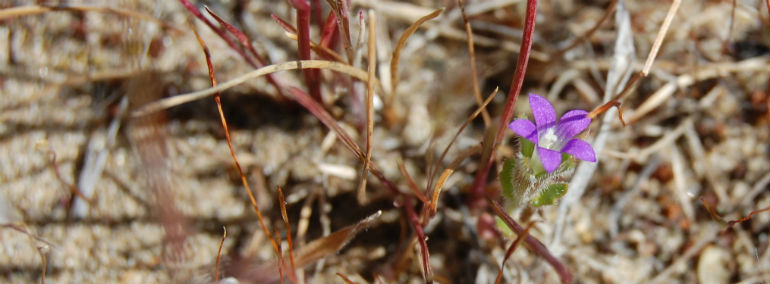
Rare Species
In Washington state, nearly 10% of the vascular plants and 14% of the vertebrate animals are considered to be rare or at risk. Species may be naturally rare, like those with small geographic ranges or specialized habitat requirements, or rarity may be due to human-induced changes in the landscape. The Endangered Species Act of 1973 legislated conservation efforts on behalf of those species at greatest risk of extinction, recognizing their “…esthetic, ecological, educational, recreational, and scientific value.” Rare species may serve as indicators of ecological health, they may be keystone species in ecosystems, or contain genetic material of potential value in the development of food and medicine. Ultimately, broad knowledge of species and ecosystems is essential to making wise decisions about the use of our natural resources, so we may benefit from their services in perpetuity.
Plants and Nonvascular Species
The Washington Natural Heritage Program (WNHP) generates lists of those plants and nonvascular species considered to be rare and of conservation concern in Washington. Using Natural Heritage Methodology, species are ranked on a scale of 1 (critically imperiled) to 5 (demonstrably secure) based on information on distribution, abundance, condition, threats and trends. Species are additionally assigned a state conservation status of Endangered, Threatened, Sensitive or Possibly Extinct/Extirpated. Additionally, we maintain lists of species under review. Review List 1 includes species for which more information is needed before a conservation status can be assigned, and Review List 2 includes species with unresolved taxonomic questions. Currently there are nearly 400 plants and nonvascular species with conservation status in the state, 12 of which are also listed under the Endangered Species Act as either endangered or threatened.
The state lists of priority species are continually revised based on new information gained through inventory, research, and monitoring. Every two years a statewide community of botanists participates in the rare plant list revision by contributing sighting records, suggesting changes or additions, and reviewing proposed lists. When external and internal review is completed, the lists are posted to our Species Lists page for public use.
More information about the plants and nonvascular species on our lists, including photos and instruction on identification, range, habitat, and threats is available through our online Field Guide to the Rare Plants of Washington.
Additional Resources
The U.S. Fish and Wildlife Service (USFWS), U.S. Forest Service (USFS) and Bureau of Land Management (BLM) also assign conservation status to rare plants. The USFWS is responsible for implementation of the Endangered Species Act as it relates to plant species, and the USFS and BLM prepare lists of Sensitive and Strategic Species based on whether they are documented or suspected on agency land in Washington (Interagency Special Status/Sensitive Species Program).
NatureServe Explorer is a source of information for more than 70,000 plants, animals, and ecosystems of the United States and Canada.
Animals
WNHP maintains a list of the state's animal species including information on conservation priorities. The list is complete for vertebrates and partially complete for invertebrates. Species and groups of species are added to the list as occurrence information becomes available. As species are added, conservation status is assessed using Natural Heritage Methodology. Information on distribution, abundance, condition, threats and trends is collected from all available sources, the most common being taxon experts, scientific literature and our own fieldwork.
Recent fieldwork conducted by our program's zoologist includes: surveys of the distribution of the Sand-verbena Moth and the Washington Ground Squirrel, a statewide survey of bat distribution and habitat use, surveys of bumblebees, a study of pollinators of federally listed plants and a compilation of information on fairy shrimp and surveys of their distribution.
Additional Resources
Legal responsibility for managing fish and wildlife species in the state is held by the Washington Dept. of Fish and Wildlife (WDFW). Construction, land use, environmental, and scientific collection permits, and information regarding legal status must be obtained from WDFW.
WDFW At-risk species page. Provides links to the web pages that are related to state-endangered, threatened, and sensitive animal species in the state.
WDFW Priority Habitats and Species Program. Provides links to PHS species list, PHS maps, and PHS management recommendations.
The U.S. Fish and Wildlife Service and the National Marine Fisheries Service maintain a list of federally Endangered, Threatened and Candidate species and Species of Concern.
NatureServe Explorer is a source of information for more than 70,000 plants, animals, and ecosystems of the United States and Canada.
Reports
A list of technical reports by Natural Heritage Program botanists and zoologists can be found here.

